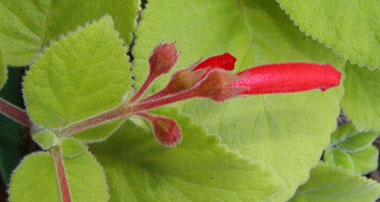Pair-flowered Cymes in Gesneriads
The best way to get the idea of a cyme (and its pair-flowered variant) is to closely examine a saintpaulia flowerstalk or a multi-flowered streptocarpus flowerstalk. Because the flowerstalks are larger than in other gesneriads, it is easier to make out the structure.
It isn't as obvious, but the pair-flowered cyme is the basic inflorescence in Sinningia too.

Somewhat ironically, one of the best pictures I have of a pair-flowered sinningia cyme is on a hybrid. This picture of Sinningia reitzii x cardinalis shows the end flower opening first, then the pair flower directly beneath it, and lastly, one on each side, the two still-developing one-flowered "cymes".
Another closeup of a pair-flowered cyme can be found on the Sinningia 'Carnival' page.

To show that the pair-flowered cyme is a unifying feature of the gesneriad family, here is a picture of a gesneriad from half a world away. This is the pair-flowered cyme of a Lysionotus, from southeast Asia.
Note that each side flower has a bud beneath it, in the pair-flower position. Thus, each "side flower" is actually a secondary pair-flowered cyme.
